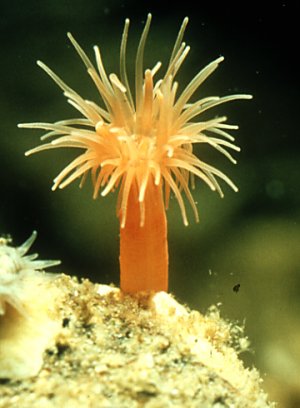Diadumenidae
- Sagartia schilleriana Stoliczka 1869
- Diadumene cincta Stephenson 1925
- Sagartia leucolena Verrill 1866
- Diadumene kameruniensis Carlgren 1927
- Diadumene neozelandica Carlgren 1924
Introduction
Carlgren's catalog (1949) recognized one genus of Diadumenidae, Diadumene, containing five species. The names listed above are the original binomina of these species. Nomenclatorial inconsistencies need to be resolved in a future revision of this genus (see below).Characteristics
Diadumenidae: Thenaria (Acontiaria) whose acontia are provided with basitrichs and microbasic p-mastigophors. No distinct sphincter. Some or all of the inner tentacles typically forming catch-tentacles provided with atrichs and holotrichs; but sometimes apparently these special nematocysts are lacking in individuals of a species which does possess them.Diadumene: Diadumenidae with well developed basal disc. Column smooth, divisible into scapus and capitulum which are separated from each other by a collar round the upper margin of the scapus. Scapus with cinclides. Margin of capitulum tentaculate. Sometimes the collar smoothes away when the body is fully extended. No distinct sphincter. Tentacles long, numerous, more or less regularly arranged not or imperfectly retractile. Some or all of the inner tentacles are typically thicker than the other tentacles, and form catch-tentacles containing, among other nematocysts, atrichs and holotrichs. In some individuals, however, these special tentacles may be absent. Outer tentacles sometimes with macrobasic amastigophors. Six or a few more perfect pairs of mesenteries. Mesenteries more numerous above than below. Retractors diffuse, more or less restricted. Parietobasilar and basilar muscles weak. Perfect mesenteries and the stronger imperfect ones fertile. Acontia well developed, with basitrichs and microbasic p-mastigophors. Cnidom: spirocysts, basitrichs, atrichs, holotrichs, microbasic p-mastigophors, microbasic and macrobasic amastigophors.
References
Carlgren, O. 1949. A Survey of the Ptychodactiaria, Corallimorpharia and Actiniaria. Kungl. Svenska Vetenskapsakadamiens Handlingar, series 4, volume 1, number 1.
Title Illustrations

Diadumene cincta.
Photo copyright © 2000, Ron Ates.
The Netherlands.
About This Page
The information provided on this page is based on Oscar Carlgren's 1949 catalog.Copyright © 1949 Swedish Academy of Sciences.
Please note that Carlgren's text contains a number of errors, and much of the information is now out of date. An update of the catalog is currently under preparation in Daphne Fautin's laboratory, and the results of this work will be incorporated in future versions of this page.
Keyboarding of Carlgren's catalog was done as part of a project to create an electronic database of the sea anemones of the world, funded by NSF Grant DEB9521819, awarded to Daphne G. Fautin. This grant is in the program Partnerships to Enhance Expertise in Taxonomy (PEET). Susanne Hauswaldt, Katherine Pearson, and April Wakefield-Pagels contributed to the keyboarding effort.
Correspondence regarding this page should be directed to Daphne G. Fautin at
Page copyright © 2000
All Rights Reserved.
Citing this page:
Tree of Life Web Project. 2000. Diadumenidae. Version 01 January 2000 (temporary). http://tolweb.org/Diadumenidae/17979/2000.01.01 in The Tree of Life Web Project, http://tolweb.org/








 Go to quick links
Go to quick search
Go to navigation for this section of the ToL site
Go to detailed links for the ToL site
Go to quick links
Go to quick search
Go to navigation for this section of the ToL site
Go to detailed links for the ToL site